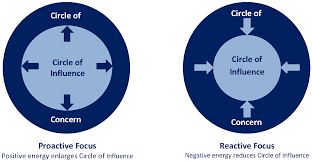The Inside-Out Approach is also referred to as the Circle of Influence [1], where your actions, non-actions, and decisions have a direct impact on your outcomes.
The key is to focus your implementation efforts on those things that you can control and influence, thus enabling you to make effective changes. Therefore, you make changes within your organization first (things that you can control and influence), before trying to direct outside suppliers or your customers to make changes that will benefit you.
Another aspect of this Inside-Out Approach is to have a narrow focus and go deep, as opposed to having a wide focus and trying to spread too quickly. In almost every instance, it is better to be more concise within your organization and focus on a single process or work cell. [2]
Inside-Out Approach, includes Narrow and Deep
But it also means that before taking 1- or maybe even 2-steps, and then deploying it throughout the entire organization, it is better to have a holistic approach [3] and understanding of 3 to 5-steps, maybe even as many as 10- to 15-steps before you start to deploy to other areas of your organization.
References, and Links to Further Explanations
- Circle of Influence adapted from The Seven Habits of Highly Effective People by Stephen R. Covey, Simon & Schuster 1992.
- Focus on a single process or work cell may utilize the Primary Elements of Our Paradigms: Pilot Area.
- Holistic Approach is one of Our Fundamentals of LEAN we have Defined: Holistic.
Insight from a Master Sensei
When you are thinking Inside-Out Approach, consider the extent of your boundary conditions within your influence and control:
- What are my boundary conditions where I am in control?
- Wat are my boundary conditions where I can influence?
- What is not in my boundary conditions and outside of my influence and control?
Make sure that you understand the extent of your boundary conditions because you have to think that these are things that I can do something about to improve and change the situation. In your first step, focus on what you can control so that you have something you can do quickly and successfully. This will build a sense of confidence and appreciation with a “Quick Win” for you and the team.

